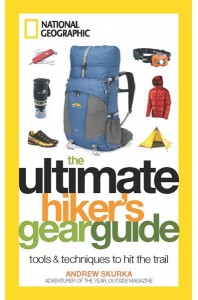 Although long distance hiker Andrew Skurka‘s book is titled as a gear guide, it offers some good background information on his style of hiking and how he decides on what gear to carry for each trip. I found the information on planning for a trip and the sample gear lists to be the best parts of the book.
Although long distance hiker Andrew Skurka‘s book is titled as a gear guide, it offers some good background information on his style of hiking and how he decides on what gear to carry for each trip. I found the information on planning for a trip and the sample gear lists to be the best parts of the book.
While the book is written for backpackers, the information except for a few areas like backpacks, umbrellas, and trekking poles would apply to bikepacking.
Why, When, and Where
Beginning section on how he plans for a trip might be the best part. Be smart, be prepared, and know what to expect with conditions.
The first section is short but packed with great information. He first describes his definition of an Ultimate Hiker which I’ll paraphrase – an ultimate hiker is someone that has the primary objective of walking lots of miles and making constant forward progress. They use a lightweight setup and they have a higher skill level which allows them to remain safe and comfortable even when carrying less gear. Due to the longer days of hiking, their trips may not be the most fun to do, but they are fun to talk about later.
The Know Before You Go chapter contains a wealth of information on resources (online and offline) that Skurka uses to plan his trips. For each trip, determine the expected weather, wildlife, precipitation, daylight hours, vegetation, water availability, etc.
Tools & Techniques
Since this is a gear guide book, the bulk of the material is covered in this section. Everything from footwear, insulation layers, rain gear, sleeping bags, tents, and cooking gear is covered. The focus is on lightweight and mostly affordable gear so there is not much mention of cuben fiber based gear.
I really liked the fact that he put weights and costs of gear he mentions because readers can get an idea of where they can save both weight and money when determining their gear. The gear section also includes several sidebars where Skurka talks about the specific gear he uses and what conditions cause him to use that setup. I found this to be very helpful to better understand gear from someone who has logged well over 10,000 miles of hiking.
The sections on pitching tarps and hiker food stood out above the rest. The tarp section went into detail about the knots and guylines Skurka as well as his technique for not pre-tying fixed length guy lines. The benefits of using his tarp techniques is that the guylines are not a fixed length so he can easily move a stake if there is a rock or obstruction. This setup also doesn’t use any tensioners that could break or get tangled when unpacking the tarp.
The section on food is also very good with tips on how he manages his food for long treks and it also includes several recipes for making your own tasty trail food. A general rule of thumb is to pack between 3500 and 5000 calories per day which is about 1.5 – 2.5 pounds. Skurka makes a point to tell the reader that they should listen to their body and find the foods that work best for them – in Skurka’s case that was finally admitting that a chocolate centered diet worked best for him.
Even though this is a gear guide, each section has a few tips and techniques to help make the gear work better for the hiker. For example, in the food section, he mentions that each night in camp, he portions out his food for the following day so he doesn’t have to rummage through his pack for items in the morning.
Sample Gear Kits
The final section contains 5 gear lists for hikes in different climates at different times of year. For me, this is something I haven’t seen in other books and I think it’s a great idea. It puts into practice the information from the other sections of the book.
The gear lists contain actual items, individual weights, and comments (reasons for choosing or alternative options). Prior to listing out the gear, Skurka goes through the trip objectives and conditions expected which impact the gear that’s selected.
The gear lists are broken into six sections – clothing worn, other clothing, shelter & sleeping, cooking & water, small essentials, and packing. At then end of each list are weight totals for base weight, food weight, skin out weight, etc.
Final Thoughts
It’s hard to get excited about a gear book, but this is a good book for anyone that wants to learn more about outdoor gear, especially since it includes actual weights and costs of items. The first section on planning and preparing for a trip makes this much more than just a gear book.
![]()
The gear talk is nice if you’re a gear junkie, but the preparation pieces are key for anyone backpacking or bikepacking. If you know the trip objectives, trail conditions, and environmental conditions, you can make smart choices about which gear is needed to have a successful trip.
